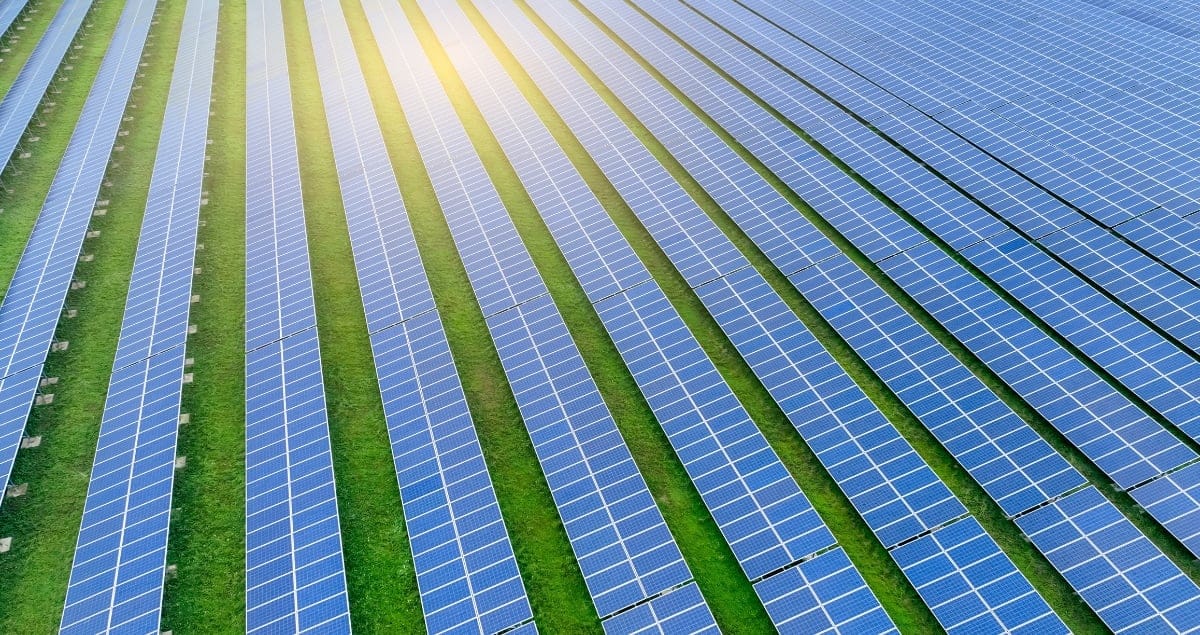What Are Solar Farms?
November 13, 2024

A solar farm is a large-scale power plant made up of photovoltaic panels that convert sunlight into electricity. These installations, also known as solar parks or photovoltaic power stations, can span several acres with hundreds of thousands of ground-mounted panels that are strategically positioned for optimal light absorption. They are typically located in open, sunny areas, and supply power at the utility level rather than for individual homeowners or businesses.
What Are Solar Farms?
A solar farm is a large-scale installation where photovoltaic panels convert sunlight into clean, renewable energy. Solar farms feed this energy directly into the power grid, or store it in batteries for later use.
Today, there are about 210 gigawatts of solar farm capacity installed across the United States, which is enough to power over 36 million homes.
“Solar farms are critical in the inevitable transition to sustainable energy and the fight against climate change,” Troy Fox, co-founder and directing manager of solar company Evergreen Electrical, told Built In. “They help to reduce carbon emissions, offer a scalable solution to meet growing energy demands, promote energy independence and are part of the bigger push to move away from fossil fuels and toward sustainable energy sources.”
Types of Solar Farms
There are two main types of solar farms: utility-scale and community solar farms.
Utility-Scale Solar Farms
A utility-scale solar farm is a large installation of solar panels that feeds power into a public grid. It’s built to produce substantial energy output for a region, often spanning hundreds of acres covered in thousands of photovoltaic panels, and is typically backed by power purchase agreements.
While most utility-scale solar farms in the U.S. range from one to five megawatts, they can reach capacities beyond 50 megawatts. In fact, the largest site to date is an 864-megawatt facility based in California’s Mojave Desert with more than 1.9 million solar panels that stretch across 4,660 acres.
Nationwide, utility-scale solar farms are the third-largest source of renewable energy, with a current capacity of 100 gigawatts, according to the American Clean Power Association.
Community Solar Farms
Community solar farms are smaller, localized projects that provide solar power to a community or group of subscribers. Typically, these farms generate an average of two megawatts across 10 to 30 acres. All power generated is used on site or distributed within a close range, with any excess fed into the grid.
Participants can buy a share of the farm to receive credits or power from the collective energy production. Through a process called net metering, energy providers can adjust a member’s utility bill based on the amount of energy generated in relation to the size of their home, often resulting in utility bill savings of 5 to 15 percent. As Fox explained, “it’s essentially like joining a solar co-op without needing panels on your roof.”
Community solar farms are a viable option for those who are not able to install their own photovoltaic systems onsite — like renters or homeowners and businesses with unsuitable rooftops. As Vihann Kong, senior executive director at community solar provider Ampion, pointed out, “many community solar customers are unable to afford the high entry-level cost of rooftop solar,” noting that these programs are a way to “keep more money in people’s pockets by delivering consistent electric bill savings.”
How Do Solar Farms Work?
Essentially, solar farms harness the sun’s free, limitless energy to make it their own. To do this, they use ground-mounted photovoltaic panels, made up of silicon-based semiconductive materials, to capture sunlight and convert it into electricity.
- When light particles hit solar panels, it generates a flow of direct current electricity as electrons move through the photovoltaic cells.
- That electricity is then converted into alternating current using an inverter, making it available for consumers once transmitted into the power grid.
- The electricity generated is then distributed to homes, businesses or industries through power lines, contributing clean, renewable energy to the overall power supply.
Traditionally, solar panels are mounted on a fixed tilt at an angle calculated for optimal sun absorption based on the site’s location. In recent years, however, newer technology has introduced single and dual axis trackers that enable solar panels to follow the sun’s movement, shifting their angle accordingly throughout the day.
While solar panels work best when pointed directly at the sun, sophisticated tracking technology creates options, said Eliav Rodman, senior marketing director at smart photovoltaic tracker solution startup Solargik. They allow solar farmers the choice of maximizing energy generation, or implementing a site-specific shading plan designed to prioritize sunlight for the crops below. This technique, known as anti-tracking, “moves panels away from the sun at specific times,” Rodman said.
Advantages of Solar Farms
Renewable Energy Source
Unlike other renewable sources, like wind or hydropower, sunlight isn’t dependent on specific geographical conditions and can be leveraged almost anywhere. As a clean alternative to fossil fuels, solar energy ensures long-term, sustainable supply of energy without depleting natural resources.
And contrary to popular belief, solar farms actually work more efficiently in colder climates and do not require direct sunlight to generate electricity. They just need sunlight, even if it’s peeking through clouds. Adrian Razo, solar field operations engineer at Eni Plenitude Wind & Energy, estimated that solar panels can produce power at sunlight values as low as 100 watts per square meter. “But then the concept of efficiency comes into play,” he added. “The more cloudy days you have, the more panels you need.”
Zero Carbon Emissions
In the first few years of operation, solar panels emit about 50 grams of carbon dioxide per kilowatt-hour of energy generated, and become carbon neutral in their third year — that’s 20 times less than emissions produced by coal-powered energy plants and includes the “carbon debt” accrued to mine materials and produce the panels themselves, according to global non-profit Cool Effect.
Long-Term Returns
Once installed, solar farms are fairly low maintenance and can generate electricity for about 25 years. They offer a stable, predictable revenue stream that pays back the initial investment of setting up its infrastructure through energy cost savings or power sales, not to mention any help that may come from government subsidies and tax cuts. In just two years, Pennsylvania State University reported $2.5 million in savings after entering a solar energy purchasing agreement.
Dual-Land Use
Although solar farms require several acres of land, it can also support other activities, such as farming or grazing, alongside solar power generation. This co-location practice is known as agrivoltaics, which merges renewable energy and agricultural production. Rodman described it as “a delicate dance between agronomists, photovoltaic asset owners and farmers, where sunlight must be carefully choreographed” to unlock the full potential of a shared piece of land.
To date, the National Renewable Energy Laboratory has identified 589 agrivoltaic projects in the U.S. — representing over 10 gigawatts of solar capacity — that create safe habitats for pollinators and native grasses, grow vegetables or host sheep.
Energy Independence
Solar farms reduce a user’s reliance on the power grid as well as imported fossil fuels. They allow local communities, cities and even entire countries to generate their own power from a renewable source, making them less vulnerable to fluctuations in volatile global energy markets. Achieving energy independence also decentralizes power production, strengthening energy security by creating more resilient grids that are less susceptible to disruptions or outages.
Disadvantages of Solar Farms
High Initial Costs
There is a steep barrier to entry when it comes to large-scale solar installations. According to Coldwell Solar, the upfront costs for a solar farm ranges between $0.89 and $1.01 per watt, which prices a one megawatt facility between $890,000 and $1 million. On the bright side, these rates are significantly cheaper than residential solar installations, which are priced at about $3.06 per watt.
Land Use
Solar farms require large plots of land, often in rural or undeveloped regions, in order to make an installation economically viable. For every megawatt of installed capacity, it’s estimated that a solar farm would require anywhere from four to six acres of land. Occupying large areas of land may create competition for agricultural, residential or natural land uses. This can lead to conflicts in densely populated areas where space is limited or valuable for other purposes, such as food production or conservation.
Sun Dependence
Solar farms need sunlight. And while sunlight hits nearly every part of the earth’s surface, its intensity varies, making some regions more ideal than others. Even in consistently sun-baked deserts, energy production is bound to fluctuate based on weather conditions, time of day and seasons, making solar less reliable than some other energy sources.
Short Life Cycles
Solar panels have a fairly limited operational lifespan of about 25 to 30 years. And as panels age, their efficiency declines, reducing the overall energy output of the farm over time. The disposal and recycling of old panels can also create environmental hazards, spilling materials like cadmium or lead, if handled poorly. Government-backed recycling programs could curb this risk.
What is a solar farm?
A solar farm is a large-scale installation where photovoltaic panels convert sunlight into clean, renewable energy.
What are the benefits of solar farms?
Solar farms make it possible to produce clean, renewable energy from sunlight — a plentiful resource that’s available almost everywhere in the world. These carbon-neutral systems also have significant long-term returns on investment, and allow for dual-land use as well as a path to energy independence.
What are the negatives of solar farms?
The downside to solar farms is that they require vast amounts of land and a high initial investment. Solar energy production can also be inconsistent, as it depends on many variables such as the sun’s intensity, weather conditions and time of day.
Search
RECENT PRESS RELEASES
Related Post




